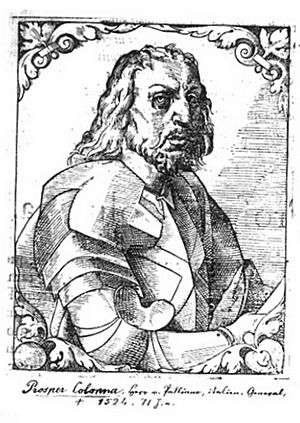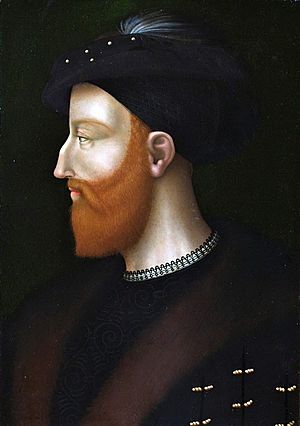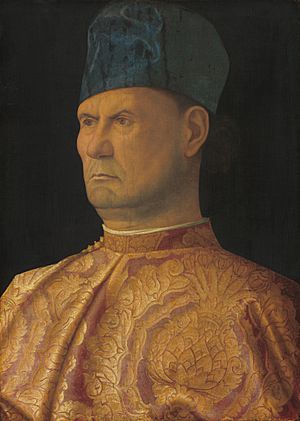Battle of La Motta (1513) facts for kids
Quick facts for kids Battle of La Motta |
|||||||
|---|---|---|---|---|---|---|---|
| Part of the War of the League of Cambrai | |||||||
 Portrait of Prospero Colonna (1452–1523), Italian condottiere |
|||||||
|
|||||||
| Belligerents | |||||||
| Commanders and leaders | |||||||
| Bartolomeo d'Alviano | |||||||
| Strength | |||||||
|
|
||||||
| Casualties and losses | |||||||
| Over 4,500 casualties | Unknown, but minor | ||||||
The Battle of La Motta was a major battle that happened on October 7, 1513. It is also known by other names like the Battle of Schio or the Battle of Vicenza. This important fight took place near Schio in the Veneto region of Italy. It was a key part of a bigger conflict called the War of the League of Cambrai.
In this battle, the army of the Republic of Venice fought against a combined force from Spain and the Holy Roman Empire. The Venetian army, led by Bartolomeo d'Alviano, suffered a big defeat. The Spanish and Imperial forces were commanded by Ramón de Cardona and Fernando d'Ávalos.
How the Battle Started
The Venetian commander, Bartolomeo d'Alviano, found himself without help from France. He had to retreat into the Veneto region, with the Spanish army, led by Ramón de Cardona, following him closely.
The Spanish army tried to capture the city of Padua but couldn't. However, they pushed deep into Venetian land and even got close enough to see Venice itself in September. Ramón de Cardona, who was the Spanish Viceroy of Naples, tried to bomb Venice. But his attack didn't do much damage because he had no ships to cross the water around the city. So, he decided to turn back towards Lombardy.
Meanwhile, D'Alviano's army got stronger. They received hundreds of new soldiers, including volunteers from important Venetian families. They also got more cannons and other supplies. With these new resources, D'Alviano decided to go after Cardona's army. His goal was to stop the Spanish from leaving the Veneto region.

The Battle Itself

On October 7, 1513, the Venetian army, led by Bartolomeo d'Alviano, finally met Cardona's army outside Vicenza. Vicenza is a city in northeastern Italy.
The Spanish and German foot soldiers, about 7,000 men in total, were led by Fernando d'Ávalos and Georg von Frundsberg. They were in a good position and ready to fight. They launched a very strong attack against the Venetian army. This attack caused a huge number of deaths and injuries for the Venetians, with over 4,500 people killed or wounded. This was a terrible blow to the Venetian forces. It forced them to run away, and D'Alviano's entire army scattered.
Even after this big battle, the two armies continued to have smaller fights. These skirmishes happened in the northeastern region of Friuli-Venezia Giulia for the rest of 1513 and through 1514.
What Happened After
Even though the Venetians lost badly to the Spanish, the Holy League (an alliance of European powers) didn't fully take advantage of their victory.
A big change happened when the King of France, Louis XII, died on January 1, 1515. His successor, Francis I, became king. When Francis was crowned, he also claimed the title of Duke of Milan. He immediately decided to get back the lands France had lost in Italy.
A combined army of Swiss and Papal (Pope's) forces moved north from Milan. They wanted to block the mountain passes in the Alps to stop Francis. But Francis found a different way, marching through the valley of the Stura. The first part of the French army surprised the Milanese cavalry at Villafranca and captured Prospero Colonna. Soon after, Francis and the main French army faced the Swiss at the Battle of Marignano on September 13.
See also
 In Spanish: Batalla de La Motta para niños
In Spanish: Batalla de La Motta para niños
- War of the League of Cambrai
- Battle of Marignano
- Italian Wars
- List of battles of the Italian Wars
Images for kids


